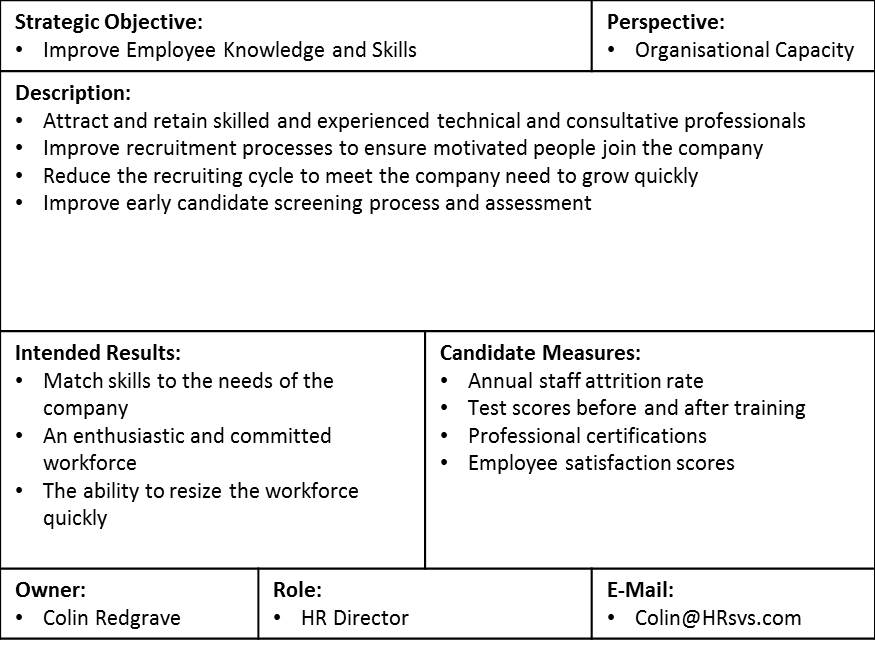Nine Steps to Success™ – Part 3 Strategic Objectives
Strategic Objectives is the third step of the Balanced Scorecard Institutes framework for strategic planning and management, the Nine Steps to Success™.
It has to be made clear from the outset and with no ambiguity whatsoever; a Strategic Objective is a continuous improvement activity.
It is not an activity that has an end point, it is not a project, it is not a programme, it is a continuous improvement activity and must be described as such. Synonymous with strategic objectives are words like improve, increase, strengthen, decrease, reduce and enhance. They are verbs that are used to describe on-going activities. Why is it so important to recognise that a strategic objective is a continuous improvement activity? Because strategic objectives are considered to be the DNA of the Balanced Scorecard system. Getting a strategic Objective right is crucial to the success of the follow-on steps of strategy mapping, performance measures, targets and strategic initiatives. Getting it right at the start will put into place all of the elements required to create a successful balanced scorecard system, getting it wrong can lead to a poor implementation and days of re-work.
In their book, ‘The Institute Way’ Howard Rohm et all say:
“The institute Way improves on these earlier scorecard designs by treating strategic objectives as continuous improvement activities that, when linked together in a visual representation, illustrate the value-creation process as a strategy map.”
They go on to advocate four things that should be done in sequence when creating strategic objectives, they are:
1. Develop strategic objectives for strategic themes
2. Create company-wide strategic objectives from theme objectives
3. Describe and document the strategic objectives
4. Identify objective owners, their roles and responsibilities
Develop strategic objectives for strategic themes
Typically this is undertaken as a group activity. It is vital to have the right people attend and ensure a cross-section of the organisation is represented. This is not simply an executive activity. At this stage, all ‘candidate’ strategic objectives should be considered. The starting points for this activity are the Strategic Results developed for the Themes in the Strategy Step. Candidate strategic objectives should be considered by answering the question “What do we have to do on a continuous basis to achieve this desired strategic result?” It is not unusual for this to be a ‘brainstorming’ session where all strategic objectives are considered, written on a sticky note and placed on a wall.
When enough time has been given to the brainstorm, then the candidate strategic objectives can be grouped using affinity group techniques and placed in ‘Perspective’ order. It is important to place the candidate objectives into the perspective layers of Financial, Customer, Internal Processes and Organisational Capacity to establish value-creation linkages. That is, a strategic objective in a lower level will drive a strategic objective in an upper level. When all of the strategic objectives have been placed under each Theme and in a related perspective, it is important to take a step back and check for balance. You should see a similar number of objectives in each perspective and theme. As a guide, there should be between 12-14 strategic objectives per theme with 3-4 in each perspective. More than 14 usually indicate that the strategic objectives are too low level; this will result in an over-complicated value-creation story. Less than 12 will lead to gaps in the logic during the strategy mapping phase. It is a good idea to write some level of commentary at this stage to ensure full meaning is retained. Writing the full description will take place a little later (see below).
Create company-wide strategic objectives from theme objectives
This activity provides the elements needed to create a company strategy map. The process is relatively simple, that is to affinity group the strategic objectives just created for the strategic themes (above) so that there are 12-14 left for the top-most level view. However, it is equally vital to get this part of the process right. This top-most level strategy map will become highly visible; it is one of the prime mechanisms used to communicate the company strategy.
For government and non-profit organisations the process is more-or-less the same although the emphasis may change. For example, mission driven financial strategic objectives will reflect cost effectiveness rather than profit.
Describe and document the strategic objectives
It is imperative to accurately describe what is meant by each strategic objective. The discussions that take place during the development stage will undoubtedly be fully understood by the participants at the time. However, at later stages or when other people become involved, the true meaning of a three word strategic objective like ‘Strengthen Strategic Partnerships” will be open to all sorts of interpretation. For example, do we mean supplier partnerships or reseller partnerships?
A table like the one below could be used to capture all if the information required:
In the example above some candidate measures have been added to the description, this is not mandatory but it provides the owner of the strategic objective some guidance on how to proceed.
Identify objective owners, their roles and responsibilities.
By identifying and assigning ownership to a strategic objective, responsibility and accountability is assigned as well. This is hugely important when developing a strategic management system and creating a scorecard. Ownership means accountability for results; it also means that the business or organisation has taken a positive step towards resourcing and supporting the development of a strategic objective. An owner does not have to be an executive member or even a manager. Often the best owners are subject-matter experts or process experts. The key is to ensure, that from an organisational perspective, the owner has or is given the right level of authority to proceed.
An individual can own more than one strategic objective but history suggests that a one to one relationship i.e. one owner, one strategic objective tends to provide the best results. If ownership of multiple objectives is given to one person, e.g. the strategy director, then a usual outcome is for the rest of the management team and the staff to ‘let him get on with it’. We mustn’t forget that everyone gets swept up in their ‘day jobs’ and unless they are given space and time and the correct levels of authority to proceed, they will focus on the usual fire-fighting and not on strategic imperatives.
In conclusion, strategic objectives are the building blocks of strategy, the DNA of the balanced scorecard system. Creating strategic objectives correctly will provide the foundations for a successful strategic planning system and enable the latter steps.
Strategic Objective is the third step in a strategic planning journey. The Nine Steps to Success™ is a strategic planning methodology created by the Balanced Scorecard Institute. For more information on how to be trained as a Balanced Scorecard Profession (BSP) visit our training pages on the website.



